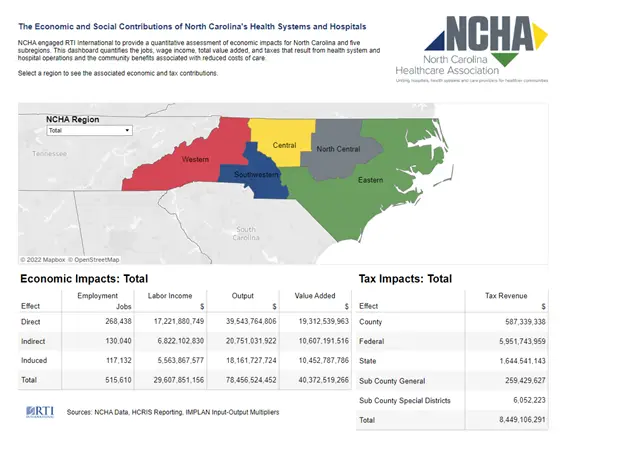Although the recent COVID-19 pandemic heightened public awareness of hospitals’ key role in community response to emerging health risks, the economic impacts that health systems and hospitals have on their communities are less understood. Recently, our team at RTI collaborated with the North Carolina Healthcare Association to estimate the economic impacts and social contributions of health systems and hospitals in North Carolina to show just how important these institutions are to the State’s economy.
By using an input output model, IMPLAN, and 2020 data for 137 facilities from the Healthcare Cost Report Information System, we determined that health systems and hospitals spent approximately $31 billion in 2020 on staff and operating expenses and an additional $3 billion on new healthcare facility construction. This spending makes health systems and hospitals a significant economic driver, sustaining jobs and secondary businesses across the state. In fact, more than 6% of North Carolina’s Gross Domestic Product (GDP), or the value of final goods and services, is produced by health systems and hospitals.
Jobs, Jobs, Jobs for North Carolina
Health systems and hospitals directly created 268,000 jobs in 2020, making them one of the 10 largest employers in 92 of North Carolina’s 100 counties and a top 3 employer in 45 counties (U.S. Bureau of Labor Statistics, 2021). In addition to healthcare practitioners, health systems and hospitals employ people with a wide range of skills in support occupations such as office and administrative professionals, customer and food service workers, and groundskeepers.
The restaurant across the street, a community coffee spot, and the drug store downtown? Those are partially supported by health system and hospital operations and workers too. We estimate that the health system and hospital sector supported an additional 247,000 jobs in other industries such as employment services, real estate services, restaurants, business consulting, and retail. Altogether, more than 500,000 jobs, or 8% of all jobs in the state, were supported by health system and hospital activities.
Community Benefits from Health Systems and Hospitals
In addition to being an important source of employment, health systems and hospitals give back to their communities. In 2021, health systems and hospitals provided $5.79 billion in community benefits, which included charity care, losses from Medicare and Medicaid, graduate medical education, donations, and services (NCHA, 2021). Charity care consists of free or discounted care directed toward the community’s poor who cannot pay for hospital services. Patients are eligible if they qualify under the hospital’s financial assistance policy. Medicaid and Medicare losses reflect hospitals providing services to these populations without getting full reimbursement for the cost of care. Each year, health systems and hospitals write off hundreds of millions of dollars of compensation owed to hospitals.
Health systems’ and hospitals’ operations, workers, and suppliers paid $2.5 billion in state and local taxes, which sustained crucial public services such as K–12 education, law enforcement, and social services. In addition, health systems and hospitals paid state fees to offset costs for programs such as Medicaid. Each year, $112 million of the annual assessments paid by health systems and hospitals are contributed to the state’s General Fund.
Although health systems and hospitals are located in all parts of the state, employment and spending were concentrated in the parts of the state with large or growing populations, including the greater Charlotte area and the Research Triangle region, which includes Raleigh, Durham, and Chapel Hill. To learn more about hospitals’ spending, economic impacts, and community health measures, check out the interactive dashboard on NCHA's website. Here, economic impact data are presented for North Carolina and five subregions of the state.
Compassionate Cancer Care
Throughout North Carolina, hospitals large and small continually strive to provide cancer care to patients in progressive facilities that offer advanced therapies. Most people prefer to stay in their community to receive treatment and support, and all hospitals that offer cancer services to North Carolinians work hard to provide high-quality and compassionate care.
For example, the UNC Rex Cancer Center recently opened in a new, four-story building across the street from UNC Rex’s main Raleigh campus. Designed with input from patients and their families, services include a Quality-of-Life Clinic with a variety of support services for cancer patients, including behavioral health care, rehabilitation services, and holistic treatment.
In the Sandhills, FirstHealth of the Carolinas plans to open a comprehensive cancer center in Pinehurst in early 2023. The 120,000-square-foot building will bring together all of FirstHealth’s outpatient cancer treatments in a single location. It also will house services such as palliative care, research and clinical trials, nutrition services, and a wellness center.

Learn More
See the complete report, "The Economic Contributions of North Carolina’s Health Systems and Hospitals," at the North Carolina Healthcare Association.


